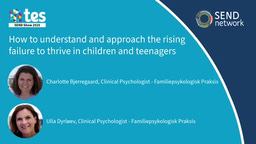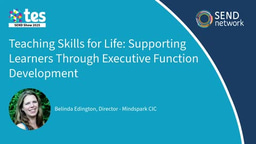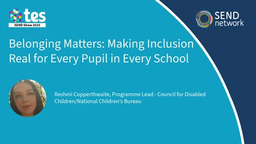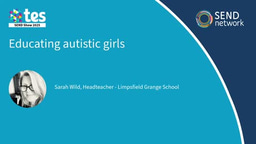Inclusion - Reaching out

In the London Borough of Kingston, applications for SEND inclusion funding have doubled over the past three years, while there have been continual reductions in Government support. This is not an uncommon story, but Achieving for Children (AfC), a not-for-profit company which runs children’s services for Richmond and Kingston councils, has come up with an innovative way to tackle the issue.
NEW PROJECT
In early 2018 AfC applied for a £45,000 grant from the DfE’s 30 hours delivery support fund. We wanted to develop a project which developed practitioners’ skills in SEND and which would allow these new skills to be passed on to other practitioners. It would also aim to improve outcomes for all children with SEND, including those with complex needs. While AfC has increased the amount of SEND training and networks available, plus providing an early years SEN conference, practitioners are always keen to learn from peers. So we decided to create a network of skilled and inclusive settings, called ‘inclusion hubs’.
Hubs would provide other settings in the two boroughs with peer-to-peer support, mentoring and practical guidance, and play a crucial role in early identification and intervention. The project was set to last two years: the first spent upskilling practitioners, and the second developing hub settings.
Applications opened to the PVI sector in mid-2018, with the aim to have a range of settings represented. The 12 hub settings we chose had demonstrated the ability to improve their own inclusive practice.
We analysed all our applications for inclusion funding since 2017 and training was thus focused on these areas (see table overleaf). Training was delivered by the service leads at Achieving for Children and our health partners, who could provide local context (e.g. identification and referrals).
Training
- Educational psychology* 1 day
- Assessing and supporting social and emotional competence 1 day
- Portage (accredited by the National Portage Association)* 3 days
- Speech, language and communication needs* 3 days
- Occupational therapy and physiotherapy* 1 day
- Sensory impairment* 1 day
- Practical strategies half day
- Navigating the Local Offer half day
*videos about each starred training area are available at https://bit.ly/2LnkLEg

EVALUATING IMPACT
1. A setting audit: The hubs carried out an audit of their setting three times during the course of the project. This included scaling themselves out of 8 on working with parents, planning transitions, SEND policy, SEND provision, monitoring and tracking and making referrals. The final audit found a significant impact on setting practice across all areas tested.
2. Practitioner confidence: On average, 58 per cent of practitioners rated themselves as feeling confident before training, and 98 per cent after.
3. Outcomes on children with SEND: The inclusion hub setting was required to submit, over three terms, the age and stage of development of two children with SEND at their setting. On average the children’s development progressed by five months over the nine-month period.
4. Children’s Centre programme: Practitioners from local Children’s Centres also attended the training programme. This led to a new early intervention project, launched in October 2019. Delivered every half-term, the ‘Chat and Play’ sessions are delivered by the professionals who are involved in the inclusion hub training, supported by a trained Children’s Centre practitioner. The first term of delivery has resulted in 98 per cent of parents feeling confident about supporting their child’s needs, an increase from 63 per cent.

LESSONS LEARNED
The project was also a chance to learn lessons. These are:
The importance of a constant person from each inclusion hub attending all training sessions. In addition, a full training programme with dates was shared with the hubs in advance, and a £500 grant was paid to each hub setting to help with supply costs.
That it is important to make explicit that all inclusion hubs must cascade what they learned from the training within their own settings. The focus of the Educational Psychology session helped as it was on learning styles and reflected on practice within these settings, so staff developed an understanding of how important it was to first embed the learning within their own teams before sharing with others.
Understanding that the expectation for everyone involved to attend all 13 days of training may not always be realistic.
The importance of a framework for settings to embed learning, allowing them to reflect and develop resources and materials to support other settings.
FUTURE
The second phase of the project, monitoring the impact on settings that have received the outreach, is being undertaken this year.
In addition, AfC will also fund an additional year of delivery with 16 new inclusion hub settings across Kingston and Richmond. Delivery began in September 2019 and will conclude by June 2020, at which point the 16 new inclusion hub settings will be expected to take on their role of delivering outreach.
GET IN TOUCH
Settings in Kingston and Richmond that would like to access support from the inclusion hubs are required to complete a request form at https://kr.afcinfo.org.uk/.
Case study
One hub setting explains how the training made a difference to a child with significant needs.
Tom, three, was at expected levels of eight to 16 months across the EYFS. He had no way of communicating with staff and showed no eye contact. On arrival he would be very agitated. He did not sit down for any length of time, and wasn’t able to join in group activities. Tom’s need to seek sensory stimulation meant everything went in his mouth. The exception was his physical skills, which were well developed, and he would try to calm himself by running and climbing. He would have tantrums if he could not go outside.
We accessed help from a speech and language therapist, occupational therapist and educational psychologist. Their recommendations included using the SCERTs approach, such as thinking about how adults are interacting with him to encourage communication and build up a trusting relationship, and considering why he is behaving in certain ways. We also attended training, including a course on visual signs.
We understood the unpredictability of the setting was distressing for Tom and developed strategies to help soothe him. For example, we developed a daily routine for him and started using visuals to help him predict what is coming next, showing him a photo before he moves to a different activity. We let him have time to adjust at the beginning of the day by taking him to a quiet space.
We also ensure we are able to support Tom’s sensory needs and help him regulate his emotions, through various strategies: allowing him access to a ball pond, using a large yoga ball to roll on and giving him big hugs. We have also included sensory toys in his daily activities. To support communication we are using the ‘what’s in the bag?’ activity. We have also learnt to reduce our language, and instead use the key words we would like him to say.
Tom now looks for adult interaction, gives eye contact and he seeks out adults to meet his needs. The progress has allowed us to further develop the relationship with his family.
By Rob Dembrey





Please sign in or register for FREE
If you are a registered user on SEND Network, please sign in